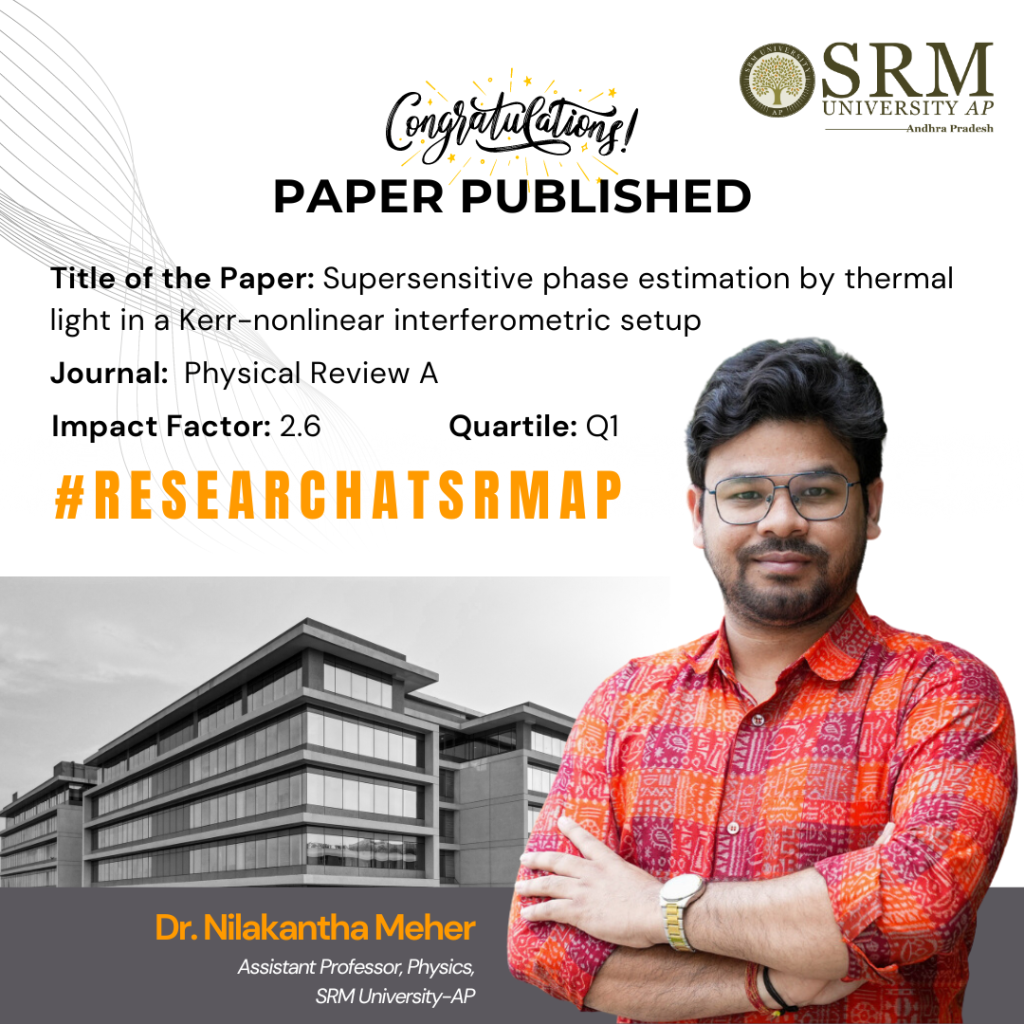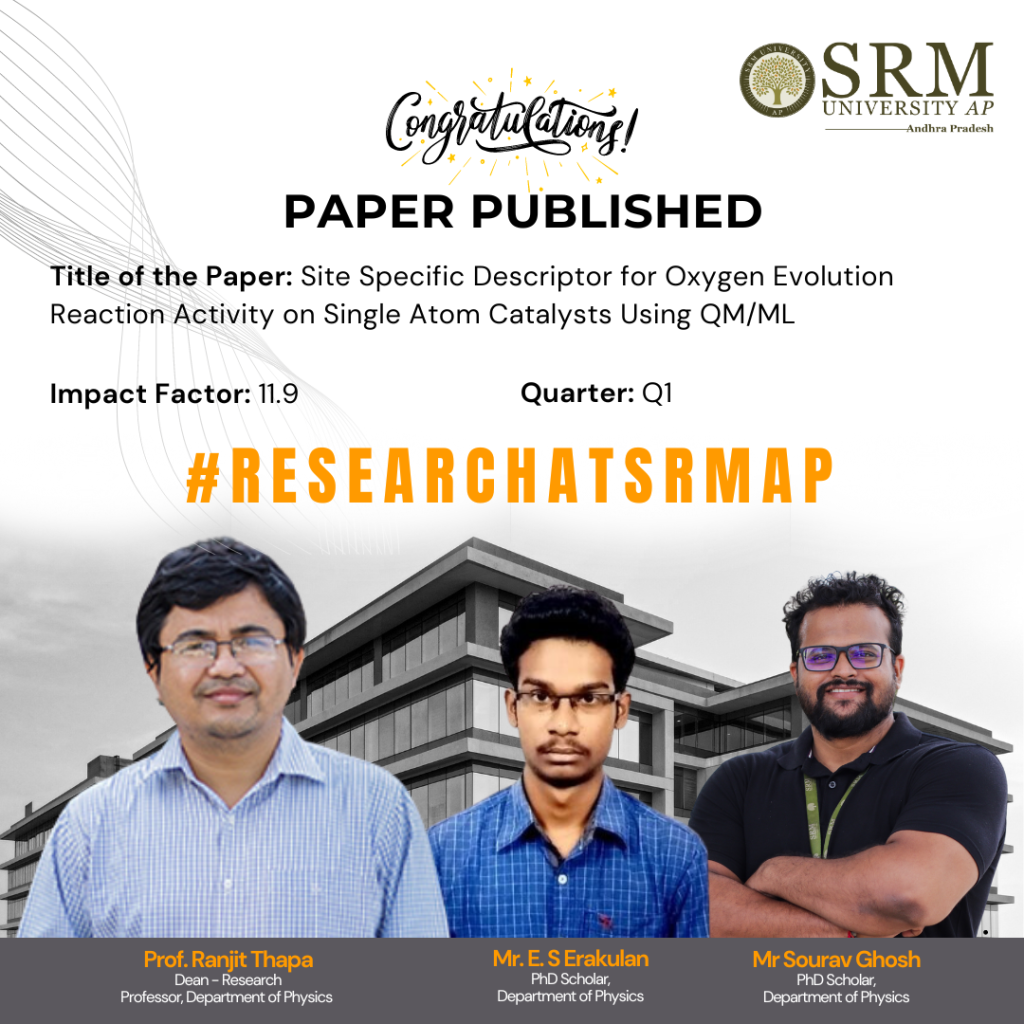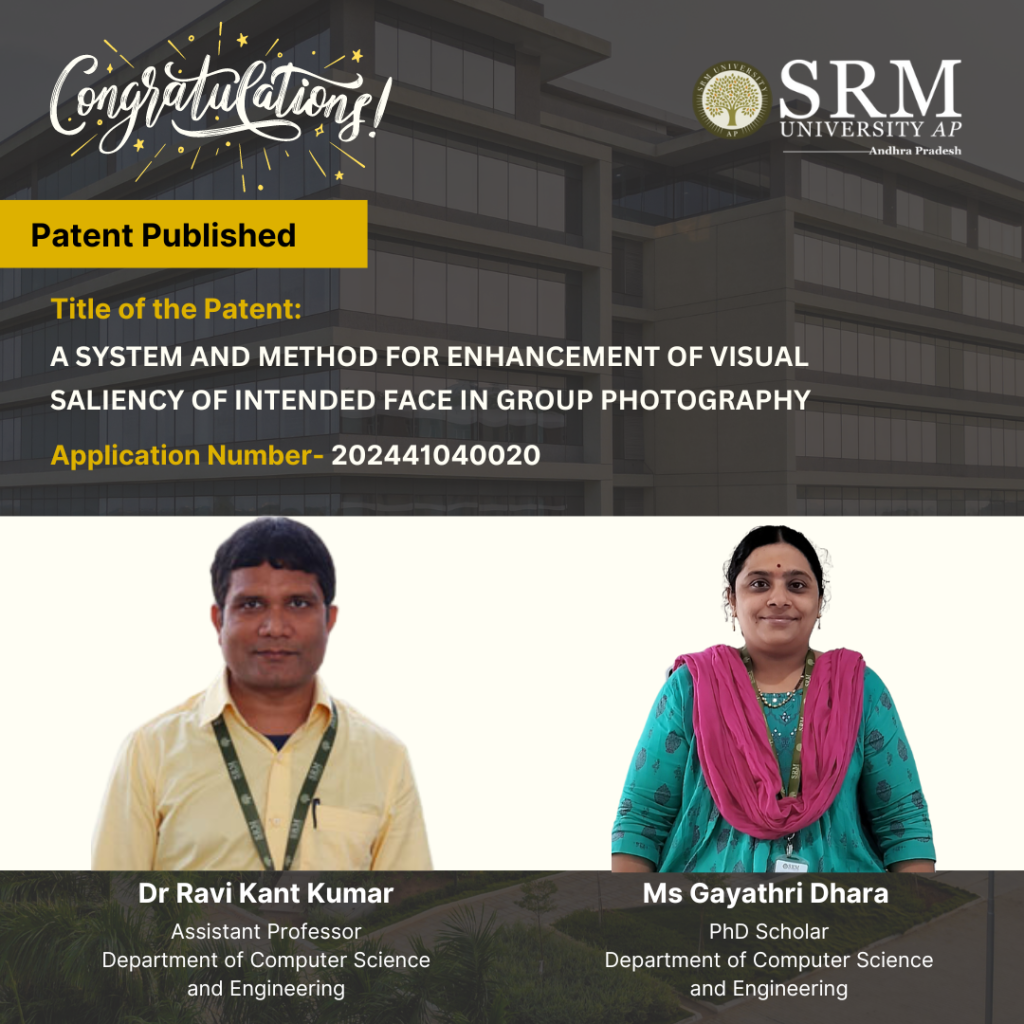All Management Events
- Dr Mallavalli Sitharam September 12, 2024
- SRM AP Offers Relief to Flood Victims September 11, 2024
Eenadu
Continue reading →

Sakshi

Andhra Jyoti

Andhra Patrika

Paalan Daily

Seema Raatnam

Visalaandhra

Andhra Prabha

Praja Sakthi

- Dr Sourav Sen September 11, 2024
- Dr. Sri Sourya Sri Harsha Rongala September 10, 2024
- Dr Chiranjeevi Korupalli September 10, 2024
- Susmi Jacob September 6, 2024
- Dr Nilakantha Meher’s Research Uses Light to Improve Object Detection Precision September 5, 2024

Dr Nilkantha Meher, an Assistant Professor in the Department of Physics at SRM University-AP, has significantly contributed to science with his research paper on using thermal light to detect objects with unmatched precision. This phenomenal work that featured in the journal Physical Review A will positively contribute to the fields of sensing, gravitational wave detection, and phase microscopy.
Abstract:
Estimation of the phase delay between interferometer arms is the core of transmission phase microscopy. Such phase estimation may exhibit an error below the standard quantum (shot-noise) limit, if the input is an entangled two-mode state, e.g., a N00N state. We show, by contrast, that such supersensitive phase estimation (SSPE) is achievable by incoherent, e.g., thermal, light that is injected into a Mach-Zehnder interferometer via a Kerr-nonlinear two-mode coupler. The phase error is shown to be reduced below, being the mean photon number, by thermal input in such interferometric setups, even for small nonlinear phase-shifts per photon pair or for significant photon loss. Remarkably, the phase accuracy achievable in such setups by thermal input surpasses that of coherent light with the same. Available mode couplers with giant Kerr nonlinearity that stems either from dipole-dipole interactions of Rydberg polaritons in cold atomic gas or from cavity-enhanced dispersive atom-field interactions may exploit such effects to substantially advance the interferometric phase microscopy using incoherent, faint light sources.
Practical Implementation:
The proposed nonlinear interferometer in this research can serve as a robust quantum sensor, making it suitable for a range of applications, including object sensing, gravitational wave detection, and phase microscopy.
Your Collaborations:
Prof. Gershon Kurizki (Weizmann Institute of Science, Israel)
Prof. Tomas Opatrny (Palacky University, Czech Republic)
Dr. Eilon Poem (Weizmann Institute of Science, Israel)
Prof. Ofer Firstenberg (Weizmann Institute of Science, Israel)Future Research Plans:
He is currently investigating the sensing of quantum entanglement and generating highly nonclassical states using various nonlinear interferometers. This research has significant implications for distributed quantum communication and quantum information processing.
Continue reading → - Paper on Deciphering Oxygen Evolution Reaction Activity: A QM/ML Approach with Single Atom Catalysts September 5, 2024

Prof. Ranjith Thapa in collaboration with two of his research scholars, Mr E. S. Erakulan Mr Sourav Ghosh and has come up with a groundbreaking research that has resulted in the publication of a scholarly paper titled, Specific Descriptor for Oxygen Evolution Reaction Activity on Single Atom Catalysts Using QM/ML.
Abstract of the paper
Descriptors are properties or parameters of a material that is used to explain any catalytic activity both computationally and experimentally. Such descriptors aid in designing the material’s property to obtain efficient catalyst. For transition metals, d-band center is a well-known descriptor that shows Sabatier type relation for several catalytic reactions. However, it fails to explain the activity when considering same metal active site with varying local environment. To address this, density functional theory was used for single atom catalysts (SACs) embedded on armchair and zigzag graphene nanoribbons (AGNR and ZGNR). By varying the anchoring nitrogen atoms’ orientation and considering pristine and doped cases, 432 active sites were used to test the oxygen evolution reaction (OER) activity. It was observed that S and SO2 dopant helps in reducing the overpotential on Co-SAC (h = 0.28 V). Along with the d-band center, a total of 105 possible descriptors were individually tested and failed to correlate with OER activity. Further, PCA was employed to narrow down unique descriptors and machine learning algorithms (MLR, RR, SVR, RFR, BRR, LASSO, KNR and XGR) were trained on the two obtained descriptors. Among the models, SVR and RFR model showed highest performance with R2 = 0.89 and 0.88 on test data. This work shows the necessity of a multi-descriptor approach to explain OER catalytic activity on SAC and the approach would help in identifying similar descriptors for other catalytic reactions as well.
Social Implications:
Computational studies have proven to be a vital tool to predict new materials and also assess the behaviour towards various catalytic reactions. They also identify the innate properties of the material which drives the catalytic activity. It helps in designing the material with required property to improve the catalytic activity. Descriptors are such computationally obtained properties/parameters of a material that has a meaningful relation with any catalytic property of a chemical reaction. d-band center, given by Hammer and Norskov in 1995, explained the binding strength of oxygen atom on pure transition metals. The d-band center shows Sabatier type relation with chemical activity and has been widely used to explain the catalytic activity of several reactions since its formulation. The adsorbate state after interaction with delocalized s-states of the metal atom is almost constant while that resulting from d-states interaction, is split into bonding and antibonding states. Hence the s-states were not considered. It is well known that, when the dimensions of a system are lowered the states become narrow and localized. In such systems, the d-band center does not explain the catalytic activity well and it is an open research problem.
Future Projects:
Density functional theory with machine learning approach could further be used and improved on similar SACs from which a predictive model equation could be constructed. Also, the proposed models are open to exploration on other catalytic reactions as well.
The authors thank SRM University-AP and National Super Computing mission for providing the computational facility.
Continue reading → - Enhancing Visual Saliency in Group Photographs: A Novel Approach for Improved Security and Healthcare Applications September 5, 2024

Dr Ravi Kant Kumar, an Assistant Professor at the Department of Computer Science and Engineering, and his research scholar, Ms Gayatri Dhara, have come up with a patent titled “A System and Method for Enhancement Of Visual Saliency Of Intended Face In Group Photography.” The patent, with Application Number 202441040020, employs pathbreaking technology to enhance security and healthcare applications, with real-time face recognition and remote diagnostics.
Abstract:
Visual saliency is a way of figuring out which parts of a scene draw our attention the most. When looking at a crowd or a group of faces, our eyes naturally focus more on certain faces than others. This happens because some faces have dominant features that stand out more. For faces that don’t naturally catch our attention, there is a need to make them more noticeable. This new method and system are designed to do just that. The system calculates scores based on various factors like skin tone, colour, contrast, position, and other visual details. These scores help identify which face needs enhancement, making it more prominent in a group of faces. The primary advantage of this invention is its potential to improve user experience in various applications, such as photo editing, social media, security systems, and more. By giving users, the control to select and enhance a specific face, it allows for a more personalised and targeted approach to face recognition and enhancement. This could be particularly beneficial in scenarios where the user wants to highlight a specific individual in a group photo or in a crowd. Overall, this invention represents a significant advancement in the field of face recognition and image enhancement, offering a novel and user-centric approach to visual saliency. It opens up new possibilities for user interaction and control in image editing and face recognition technology.
Practical and Social Implications
The practical implementation of this research lies in its ability to identify and enhance faces within a group or crowd that do not naturally draw attention. This innovative method and system address this issue by calculating saliency scores based on factors such as skin tone, colour, contrast, position, and other visual details. These scores are then used to identify faces that need enhancement to become more prominent in a group. The system’s ability to enhance specific faces has significant practical applications in several fields.
Photo Editing: Users can easily enhance specific individuals in group photos, ensuring that everyone stands out as desired. This is particularly useful for personal photos, event photography, and professional photo editing.
Social media: Enhanced face recognition and saliency can improve user experience by allowing users to highlight specific people in their posts, making photos more engaging and personalised.
Security Systems: In surveillance and security applications, the ability to enhance less prominent faces can improve the accuracy of face recognition systems, aiding in the identification of individuals in crowded or low-visibility conditions.
Collaborations:
SRM University-AP,
Dr Ravi Kant Kumar,
Mrs Gayathri Dhara.Future Research Plans:
Future plans for this visual saliency-based face enhancement system include refining algorithms for greater accuracy and efficiency, and integrating with popular photo editing software and social media platforms for seamless user experience. The technology will be expanded into security and healthcare applications, enhancing real-time face recognition and remote diagnostics. Emphasis will be placed on reducing biases, ensuring privacy protection, and enabling user customisation. Collaborations with academic institutions will drive further research, while commercialisation efforts will focus on launching products globally.
Continue reading → - Dr Negi’s Research Exploration of the Sugeno Exponential Function and Its Multidisciplinary Applications September 5, 2024

Dr Shekhar Singh Negi from the Department of Mathematics has published a research paper titled “A note on Sugeno exponential function with respect to distortion.” Dr Negi’s research investigates the Sugeno exponential function. This research develops new mathematical tools and rules to work with a different way of measuring things, which can be useful in various fields like economics, biology, or any area where traditional measurements don’t quite fit the problem at hand.
Abstract:
This study explores the Sugeno exponential function, which is the solution to a first order differential equation with respect to nonadditive measures, specifically distorted Lebesgue measures. We define k-distorted semigroup property of the Sugeno exponential function, introduce a new addition operation on a set of distortion functions, and discuss some related results. Furthermore, m-Bernoulli inequality, a more general inequality than the well-known Bernoulli inequality on the real line, is established for the Sugeno exponential function. Additionally, the above concept is extended to a system of differential equations with respect to the distorted Lebesgue measure which gives rise to the study of a matrix m-exponential function.
Finally, we present an appropriate m-distorted logarithm function and describe its behaviour when applied to various functions, such as the sum, product, quotient, etc., while maintaining basic algebraic structures. The results are illustrated throughout the paper with a variety of examples.
Collaborations:
Prof. Vicenc Torra, Professor at the Department of Computing Science at Umea University. His area of research include artificial intelligence, data privacy, approximate reasoning, and decision making.
Future Research Plans:
To explore the aforementioned derivative and investigate results with applications in real life.
Continue reading →

